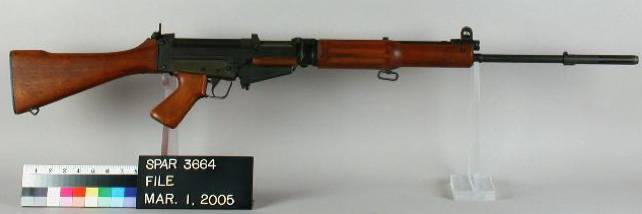

OBTW, the inch pattern “Hythe” dual-aperture variant is a great sight with the versatility needed for long range shooting, close quarters combat, and night shooting. Proper stock length usually means more accurate shooting.Ĩ.) Better rear sights. The British Maranyl pebble grain black plastic furniture is practically bomb proof.ħ.) Buttplates that come in a wide range of thicknesses, to accommodate shooters of various heights. There is nothing quite like taking a blow from metric charging handle to the solar plexus!Ħ.) Sturdier and less reflective stock furniture.

If you’ve ever tripped and fallen while carrying a metric FAL, you’ll appreciate this feature.

(Unlike the tiny mag release on the metric FAL, which is designed for the convenience of right handed shooters.)ĥ.) A sturdy folding charging handle is standard. Hence there is no way for a metric magazine to accept a dent-removing mandrel.)ģ.) A larger safety selector switch that you can’t miss with your thumb.Ĥ.) A larger, ambidextrous magazine release. (If you lay an inch mag and a metric mag side by side, you will notice that the floor plate retaining tabs on a metric magazine are turned inward, whereas they are turned outward on an inch mag. And if they ever do get dented, L1A1 magazines can be repaired with a mandrel block, but metric mags cannot. (The latter wobble a bit when used in an L1A1, but they still feed reliably.)Ģ.) Inch magazines are sturdier than metric magazines, because they are heavier gauge steel. But if you have an inch receiver rifle you can use both inch and metric mags. If you have a metric FAL, you are limited to using only metric magazines. These advantages include:ġ.) The ability to use inch OR metric magazines. I believe that there are several distinct advantages to having an “inch pattern” (L1A1) instead of one of the metric measurement FN-FALs. (My blogging income is still not yet paying all my bills.) But sadly, I had to sell it to pay some bills. Up until recently, I also owned a “ Para” FAL that had been converted to take inch magazines by Rich Saunders. Two were re-built by Century Gun Works, using pre-ban Australian inch receivers, and two were re-built by Arizona Response Systems on SAR-48 receivers that they converted to inch specifications. For what it is worth, we have four L1A1s here at the ranch, all of which are pre-ban. And if you have an even bigger budget, you might buy a pre-ban SAR-48, Argentine FM-LSR, or an original Belgian FAL. If you have a bit more money, I also recommend both Century Gun Works (CGW, run by Rich Saunders in Gardnerville, Nevada–not to be confused with Century Arms) and Arizona Response Systems for custom FAL and L1A1 builds, using post-ban receivers. Many of them have functioning problems–both feeding and cycling glitches. In contrast, the Century Arms FALs have a bad reputation for very un-even quality control. JWR Replies: I highly recommend Dave Selvaggio’s ( DS Arms) FALs. Also, will FAL’s perform equally well with either 7.62 X 51 NATO or commercial. I know there is a huge price range, but I am mainly interested in reliability (and accuracy, of course). I’ve researched from the Century “cobbled togethers” to the “new” DSA’s, etc. that: “If I ever hear shooting nearby and have my choice of grabbing either an AR-15 or FAL, then I’ll grab the FAL.” Would you please recommend/suggest a brand name of a FAL type rifle that is currently available in the U.S.? I read your FAL FAQ, but didn’t see any brand references. In the 2/23/07 blog, you replied to Stephen D.


 0 kommentar(er)
0 kommentar(er)
